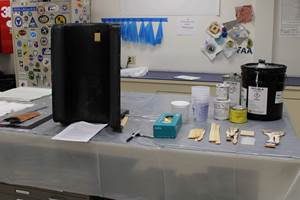Navy unveils unmanned composites-intensive vessel
This entirely new class of ocean-going vessel can traverse thousands of kilometers over the open seas for months at a time, without a single crew member aboard.
Earlier this month, the Defense Advanced Research Projects Agency (DARPA, Washington, DC, US) held a christening ceremony for the technology demonstration vessel it has developed and built through the Agency’s Anti-Submarine Warfare (ASW) Continuous Trail Unmanned Vessel (ACTUV) program. Called the “Sea Hunter,” the 130-foot drone vessel could be used for submarine tracking and countermine activities.
ACTUV is a 130-foot twin-screw trimaran, featuring a fiberglass composite exterior and foam core. The ship is designed for enhanced stability in all kinds of weather. It has a number of unusual features because it does not need to accommodate people. For example, interior spaces are accessible for maintenance but aren’t designed to support a permanent crew.
But of broader technical significance is that ACTUV embodies breakthroughs in autonomous navigational capabilities with the potential to change the nature of U.S. maritime operations, DARPA stated. Through at-sea testing on a surrogate vessel, ACTUV’s autonomy suite has proven capable of operating the ship in compliance with maritime laws and conventions for safe navigation—including International Regulations for Preventing Collisions at Sea, or COLREGS. ACTUV accomplishes this feat through advanced software and hardware that serve as automated lookouts, enabling the ship to operate safely near manned maritime vessels in all weather and traffic conditions, day or night.
ACTUV is designed to normally operate under sparse remote supervisory control but can also serve as a remotely piloted vessel, should the mission or specific circumstances require it. In either case, it would operate at a fraction of the cost of manned vessels that are today deployed for similar missions.
In September 2014, DARPA signed a Memorandum of Agreement (MOA) with the Office of Naval Research to jointly fund an extended test phase of an ACTUV prototype. DARPA will collaborate with ONR to fully test the capabilities of the vessel and several innovative payloads during open-water testing scheduled to begin this summer off the California coast after preliminary checkout and movement to San Diego. Pending the results of those tests, the program could transition to the U.S. Navy by 2018. Leidos (Reston, VA, US) is the company leading the team that built the ACTUV prototype and the construction took place at the Vigor Shipyard in Portland, OR, US.
“What we’ve created together with the Navy is a truck that can carry more payload over greater distances, stay out longer, and be more capable than anything else—and do it highly autonomously because it’s a big vessel and it’s got that flexibility,” said Scott Littlefield, DARPA program manager.
“As the chief mad scientists of the Navy, I say the best ships are partnerships,” said Rear Admiral Mathias Winter, chief of Naval Research, Innovation Technology Requirements and Test & Evaluation (OPNAV N84). “And the partnerships with DARPA, with Leidos, and our entire small, medium and large business base, and our thousands of academics and universities around the world will ensure that the Department of the Navy, the Department of Defense, and this great country and the 310 million Americans that call it home will continue to have the quality of life and the security they need as we continue to field and explore and experiment with capabilities like ACTUV.”
Here are highlights from on-water speed tests:
Related Content
Materials & Processes: Composites fibers and resins
Compared to legacy materials like steel, aluminum, iron and titanium, composites are still coming of age, and only just now are being better understood by design and manufacturing engineers. However, composites’ physical properties — combined with unbeatable light weight — make them undeniably attractive.
Read MoreNovel composite technology replaces welded joints in tubular structures
The Tree Composites TC-joint replaces traditional welding in jacket foundations for offshore wind turbine generator applications, advancing the world’s quest for fast, sustainable energy deployment.
Read MoreFostering best practices for wet layup procedures
As fabricators continue to manufacture composite tools and parts using an open mold, wet layup process — often with mixed success — it’s important to stress proper preparation, materials, application methods and standardization.
Read MoreOne-shot manufacture of 3D knitted hybrid thermoplastic composite structures
MAPICC 3D project replaces steel seat support in heavy-duty vehicle with a 3D knitted composite made from thermoplastic hybrid yarns comprising the matrix and reinforcing components.
Read MoreRead Next
CW’s 2024 Top Shops survey offers new approach to benchmarking
Respondents that complete the survey by April 30, 2024, have the chance to be recognized as an honoree.
Read MoreFrom the CW Archives: The tale of the thermoplastic cryotank
In 2006, guest columnist Bob Hartunian related the story of his efforts two decades prior, while at McDonnell Douglas, to develop a thermoplastic composite crytank for hydrogen storage. He learned a lot of lessons.
Read MoreComposites end markets: Energy (2024)
Composites are used widely in oil/gas, wind and other renewable energy applications. Despite market challenges, growth potential and innovation for composites continue.
Read More















.jpg;maxWidth=300;quality=90)










